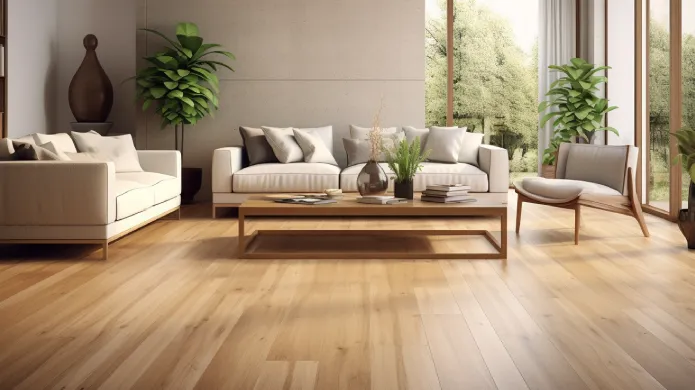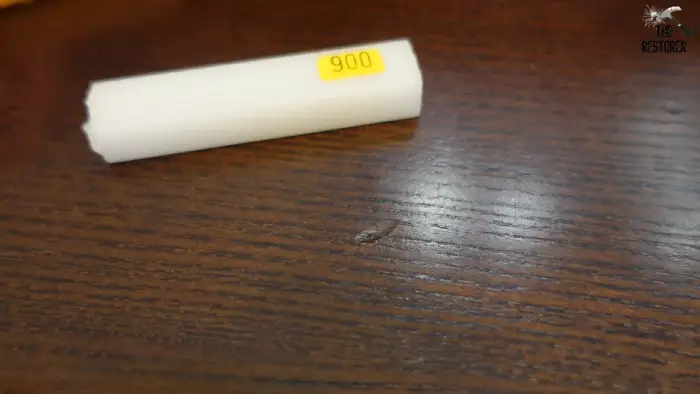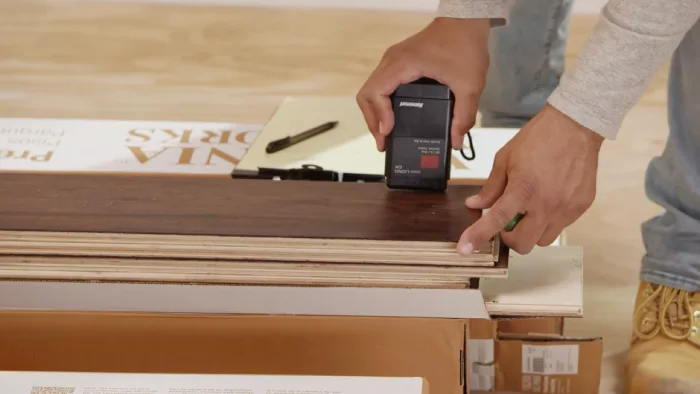Can You Lay Bamboo Flooring Over Hardwood: 3 Installation Methods
Bamboo flooring opens a plethora of possibilities for upgrading your living space. And you might be wondering if it’s feasible to integrate this eco-friendly option over your existing hardwood floors.
You can seamlessly lay bamboo flooring over your cherished hardwood, creating a harmonious blend of tradition and modernity. This endeavor becomes possible and practical with bamboo’s inherent durability and adaptability.
It can be installed over hardwood using various methods, including loose-laying, gluing, and secret nailing. We will discuss all the methods with step-by-step instructions for installing bamboo flooring over hardwood flooring.
Can You Lay Bamboo Flooring Over Hardwood: 3 Methods with Step-By-Step Guide
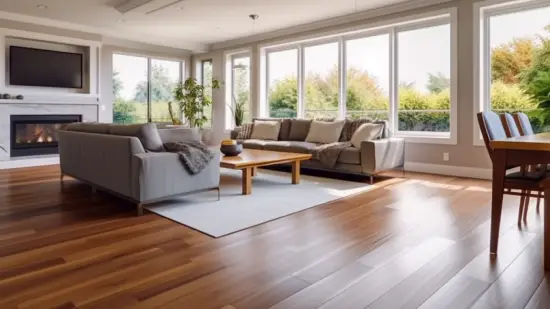
In terms of installing bamboo flooring over hardwood, there are main 3 methods you can apply.
- Method 1: Loose-lay installation
- Step 1: Prepare the subfloor
- Step 2: Acclimate the loose-lay bamboo
- Step 3: Lay the bamboo
- Method 2: Screw or nail down installation (Secret nails)
- Step 1: Clean the subfloor and let it acclimate
- Step 2: Secure the bamboo floors
- Method 3: Glue down installation
- Step 1: Sand and clean the existing hardwood floor
- Step 2: Acclimate the bamboo
- Step 3: Glue the bamboo floors
Let’s examine each method in detail for successful bamboo flooring installation over hardwood floors.
Method 1: Loose-Lay Installation
Loose-lay installation is one way to install bamboo flooring over hardwood. Before you begin the loose-lay installation of bamboo flooring, there are three crucial steps you need to follow.
Step 1: Prepare the Subfloor
To install bamboo flooring over hardwood, make sure the existing hardwood floor is clean, dry, and level.
Begin by sweeping or vacuuming the surface to remove dust and debris. Use a hardwood floor cleaner and a damp mop to gently clean the floor, making sure to wring out the mop thoroughly to avoid excess moisture. Allow the floor to air dry completely before proceeding.
Step 2: Acclimate the Loose-Lay Bamboo
Make sure the loose-lay bamboo planks have enough time to acclimate in the room for at least 10 days, allowing them to adjust to the room’s humidity.
During this period, the bamboo planks will expand or contract based on the moisture levels in the room, reducing the risk of warping or buckling later on.
Step 3: Lay the Bamboo
Start by placing the first bamboo plank against the longest wall, interlocking it with the tongue and groove design. Make sure to leave a 10mm expansion gap around the perimeter to allow for movement. Here are three important steps to lay the bamboo flooring:
- Continue laying the planks parallel to the longest wall, ensuring that each plank is securely interlocked with the previous one.
- Cut the last plank in each row to fit against the wall, leaving another 10mm expansion gap.
- Use a tapping block and mallet to ensure each plank is tightly connected and level.
Method 2: Screw or Nail Down Installation (Secret Nails
To properly install bamboo flooring using the screw or nail down method, there are two key steps you need to follow.
Step 1: Clean the Subfloor and Let It Acclimate
Ensure your hardwood floor is level and clean, so that you can lay the bamboo flooring smoothly. Here’s how to prep the subfloor and acclimate the bamboo:
- Check the levelness of the hardwood floor using a level tool. If there are any low spots, sand them down to create a flat surface.
- Clean the hardwood floor thoroughly to remove any dirt, dust, or debris. A clean surface will ensure proper adhesion of the bamboo flooring.
- Allow the bamboo planks to acclimate to the room for about 10 days. This will help them adjust to the temperature and humidity of the space, reducing the risk of expansion or contraction after installation.
Step 2: Secure the Bamboo Floors
Start with the first row of bamboo planks, securing them to the hardwood using hidden screws or nails. Place fasteners toward the center of each plank.
Once the first row of bamboo planks is secured, continue building up the rows by interlocking them and using hidden fasteners.
Make sure to stagger the planks with a minimum of 150mm between joints to ensure stability and durability. This interlocking method will provide a seamless and secure fit for your bamboo flooring.
Method 3: Glue Down Installation
To successfully glue down bamboo floors, follow a few key steps. The following are listed:
Step 1: Sand and Clean the Existing Hardwood Floor
Sand the existing hardwood floor to remove any finish. To sand the existing hardwood floor, start by preparing the area.
Remove all furniture and items from the room to ensure unobstructed access. You’ll need a floor sander, which can be rented from hardware stores, and sandpaper with varying grits, starting with coarse grit and progressing to finer grits.
Begin sanding in the corner of the room, working with the wood grain. Use the coarsest grit sandpaper to remove any old finish, stains, or imperfections.
Move the sander in a steady, even motion, overlapping each pass slightly for consistent results. Remember to wear protective gear like safety goggles and a dust mask to shield yourself from dust.
After using the coarse grit, switch to a finer grit sandpaper and repeat the process, gradually smoothing the surface. Continue this process with even finer grits until the hardwood floor is smooth and free of any roughness.
Pay special attention to any uneven areas or deep scratches, ensuring they are properly sanded down. Once the sanding process is complete, thoroughly clean the room to remove all dust and debris.
Step 2: Acclimate the Bamboo

Now that you have prepared the subfloor, it’s time to acclimate the bamboo flooring. Take the bamboo planks and place them in the room where they will be installed.
Ensure the temperature and humidity levels are consistent with the normal living conditions of the space.
Allow the bamboo to acclimate for at least ten days, keeping the planks loosely stacked to promote air circulation. This will help the bamboo adjust to the room’s environment and reduce the risk of gaps or warping after installation.
Avoid exposing the planks to extreme temperature or humidity fluctuations during this acclimation period.
Step 3: Glue the Bamboo Floors
Choose an adhesive specifically designed for bamboo flooring installation. Spread a thin, even adhesive layer onto the subfloor using a trowel or recommended applicator, ensuring the adhesive remains workable.
Work in small sections to maintain the workability of the adhesive. Avoid applying excessive adhesive to prevent it from squeezing up between the planks.
Keep the trowel at a consistent angle to achieve uniform coverage and a smooth, gap-free layer. Press the bamboo planks into place, ensuring a snug fit.
Follow the adhesive manufacturer’s recommended drying time before allowing foot traffic on the newly installed bamboo flooring.
What to Do to Maintain Hardwood Over Installed Bamboo Flooring?
To maintain hardwood over-installed bamboo flooring, there are several key points to remember. Here are some:
1. Use the Right Cleaners
You should always use non-wax and non-oil-based hardwood floor cleaners to ensure the longevity of your bamboo flooring. These cleaners are specifically formulated to effectively clean your bamboo floors without leaving behind any residue or causing any damage.
Here are three reasons why using the right cleaners is crucial for maintaining your bamboo flooring:
- Protects the finish: Non-wax and non-oil-based cleaners are designed to clean your bamboo floors without stripping away the protective finish. This helps to maintain the natural beauty and shine of your flooring.
- Prevents buildup: Using the wrong cleaners can lead to a buildup of residue on your bamboo floors, which can dull their appearance over time. Non-wax and non-oil-based cleaners prevent this buildup, keeping your floors looking clean and vibrant.
- Preserves the bamboo fibers: Bamboo is a natural material sensitive to certain chemicals. Using non-wax and non-oil-based cleaners ensures that the bamboo fibers are not compromised and that your flooring remains in top condition for years to come.
2. Frequent Vacuuming
Regularly vacuuming the floor will help to remove dirt and debris, preventing them from acting as abrasives and causing scratches.
Like any other type of flooring, bamboo flooring needs to be properly maintained to ensure its longevity and appearance.
By vacuuming frequently, you can effectively remove loose particles that may accumulate on the floor’s surface. This is especially important for bamboo flooring, as small particles can easily get trapped between the planks and cause scratches with regular foot traffic.
Make sure to use a vacuum with a soft brush attachment to avoid any potential damage to the floor. Additionally, be thorough in your vacuuming, paying attention to corners and hard-to-reach areas.
3. Protective Felt Pads
Attach protective felt pads to the legs of furniture to prevent scratching when moving items. Felt pads are an essential accessory for anyone with hardwood or bamboo flooring. Here are three reasons why using felt pads is important:
- Scratch Prevention: Felt pads act as a barrier between the furniture legs and the floor surface, preventing scratches and scuffs caused by friction. Applying these pads lets you move your furniture around without worrying about damaging your beautiful flooring.
- Noise Reduction: The soft material of the felt pads absorbs the impact and reduces the noise created when furniture is dragged or moved. This is especially beneficial in apartments or houses with multiple floors, as it helps maintain a peaceful environment.
- Easy Maintenance: Felt pads are simple to install and replace. They come in various sizes and shapes to fit different furniture legs. Regularly checking and replacing worn-out pads ensures maximum protection for your flooring.
4. Rug Placement
Placing rugs or mats in high-traffic areas and under heavy furniture can help prevent excessive wear and tear on your bamboo flooring.
You can protect your flooring from scratches and scuffs by strategically placing rugs in areas with heavy foot traffic, such as entryways or hallways.
Additionally, placing a rug or mat under heavy furniture, like couches or tables, can help distribute the weight and prevent indentations or dents in your flooring.
When choosing a rug, opt for one with a non-slip backing to ensure it stays in place and doesn’t slide around, potentially causing accidents.
It’s also important to regularly clean and maintain your rugs to prevent any dirt or debris from accumulating and scratching your bamboo flooring.
5. Monitor Humidity
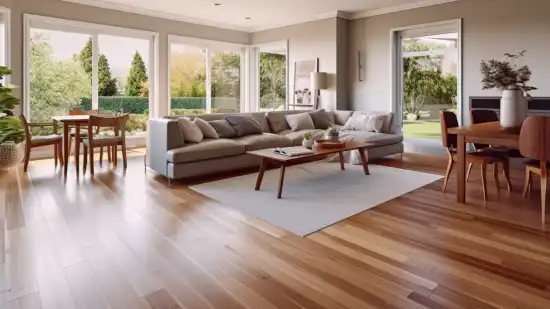
To prevent damage to the bamboo and underlying hardwood, it’s important to monitor the humidity levels in the room. Here are three reasons why:
- Prevents warping: Bamboo flooring is sensitive to changes in humidity. A high level of moisture can cause bamboo to expand and warp, whereas a low level of humidity can cause the bamboo to shrink and crack. By monitoring the humidity levels, you can ensure that they remain within the ideal range for your bamboo flooring.
- Maintains stability: Hardwood, which is often the underlying surface for bamboo flooring, is also affected by changes in humidity. Fluctuations in moisture levels can cause the hardwood to swell or contract, leading to gaps or buckling. By keeping the humidity levels stable, you can preserve the integrity of both the bamboo and the hardwood.
- Extends lifespan: By monitoring and maintaining the proper humidity levels, you can prolong the lifespan of your bamboo flooring. Excessive moisture or dryness can cause the flooring to deteriorate faster, reducing its durability and lifespan. Regularly checking and adjusting the humidity levels will help ensure that your bamboo flooring stays in excellent condition for a long time.
6. Inspect Regularly
Ensure that your flooring is regularly inspected for signs of damage or wear. This will allow you to address any issues promptly and prevent further damage.
Maintaining your flooring requires regular inspections. They help identify potential problems early on. Start by examining the surface for scratches, dents, or discoloration.
Look for loose boards, gaps, or uneven areas that may indicate underlying issues. Also, check for signs of water damage like warping or buckling. Remember to inspect the edges and corners as well.
Regular inspections allow you to catch any damage or wear before it worsens. This will save you time, money, and potential headaches down the line.
How soon can you walk on bamboo flooring installed over hardwood?
You can typically walk on bamboo flooring installed over hardwood within 24 to 48 hours after installation. However, you have to follow the manufacturer’s recommendations and specific adhesive or installation instructions to ensure that the adhesive has been fully cured and the flooring has been properly set.
Walking on the floor too soon could affect the bonding and overall stability of the installation. It’s best to prioritize allowing sufficient time for the adhesive to dry and the flooring to properly settle before resuming normal foot traffic.
What is the life expectancy of bamboo flooring?
The life expectancy of bamboo flooring can vary based on factors such as maintenance and usage. But, proper care can last for over 20-25 years and sometimes even beyond 50 years.
Bamboo flooring is known for its durability, which is comparable to many hardwoods. It is a resilient choice for flooring options, thanks to its natural strength and resistance to wear and tear.
However, you need to note that the lifespan of bamboo flooring can be affected by how well it is maintained and the level of foot traffic it experiences.
Regular cleaning, avoiding excessive moisture, and protecting it from scratches can significantly extend its lifespan. With proper care and maintenance, bamboo flooring can provide you with a beautiful and long-lasting solution for many years.
Experience the Unmatched Charm of Bamboo-Infused Flooring Over Hardwood
You now understand the possibilities and methods of laying bamboo flooring over existing hardwood floors.
By seamlessly integrating these two materials, you can create a space that blends tradition and modernity while reaping the benefits of bamboo’s durability and eco-friendliness.
Whether you opt for loose-lay, gluing, or secret-nailing methods, following the step-by-step instructions ensures a successful installation process.
With proper maintenance and care, your hardwood-over-bamboo flooring will withstand the test of time and elevate the aesthetic and value of your living space. Embrace this harmonious fusion, and you’ll enjoy it for a long time.

